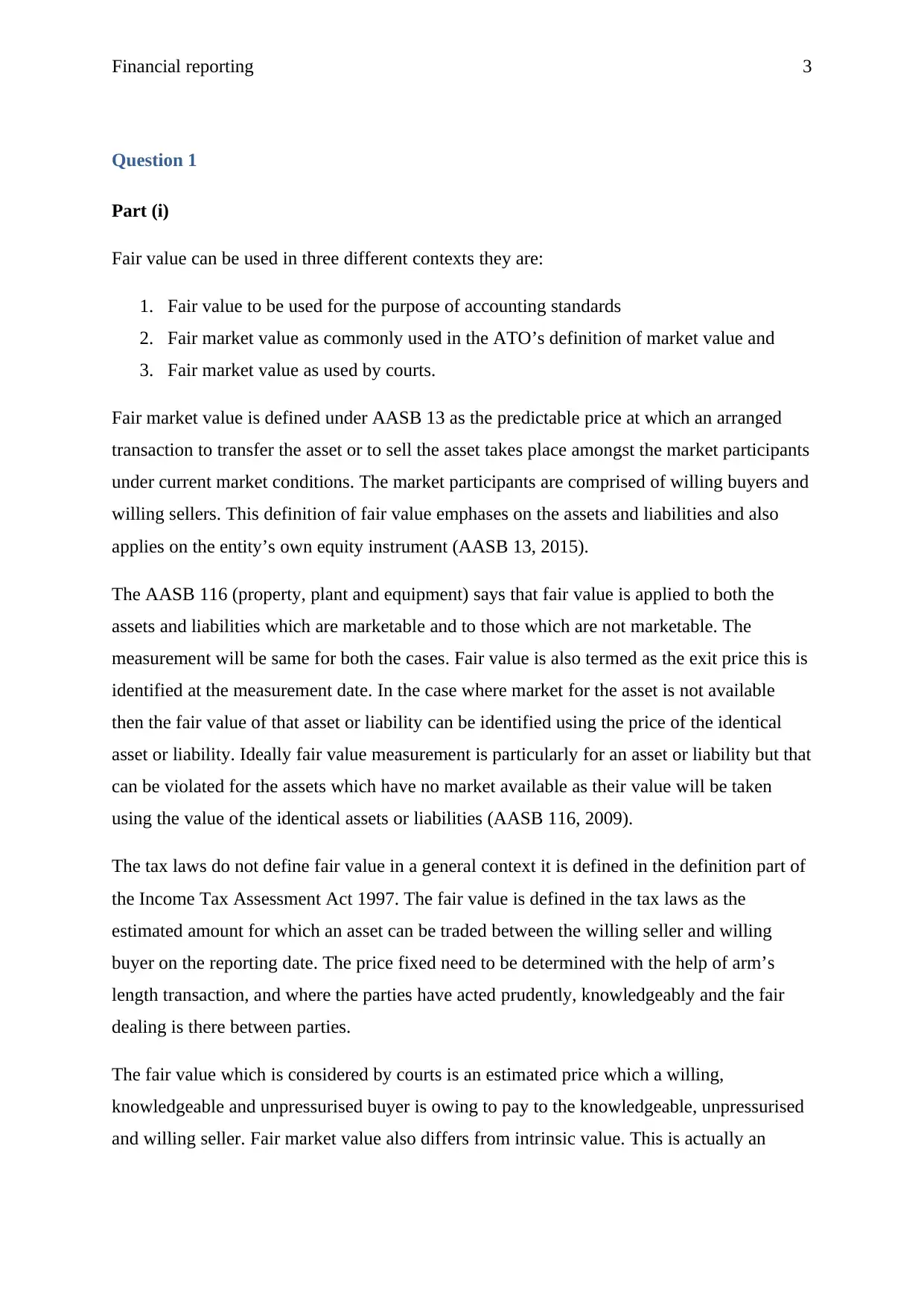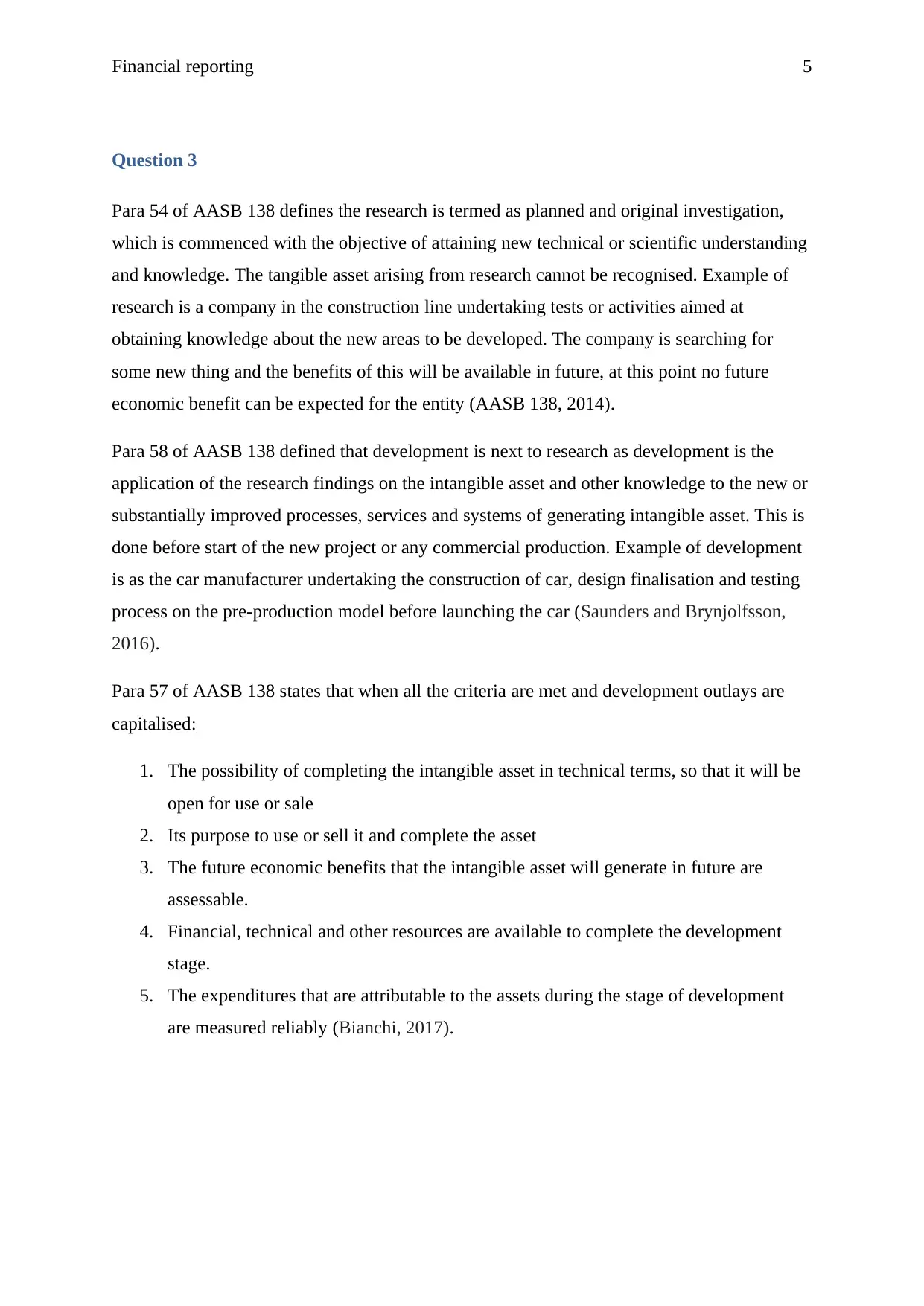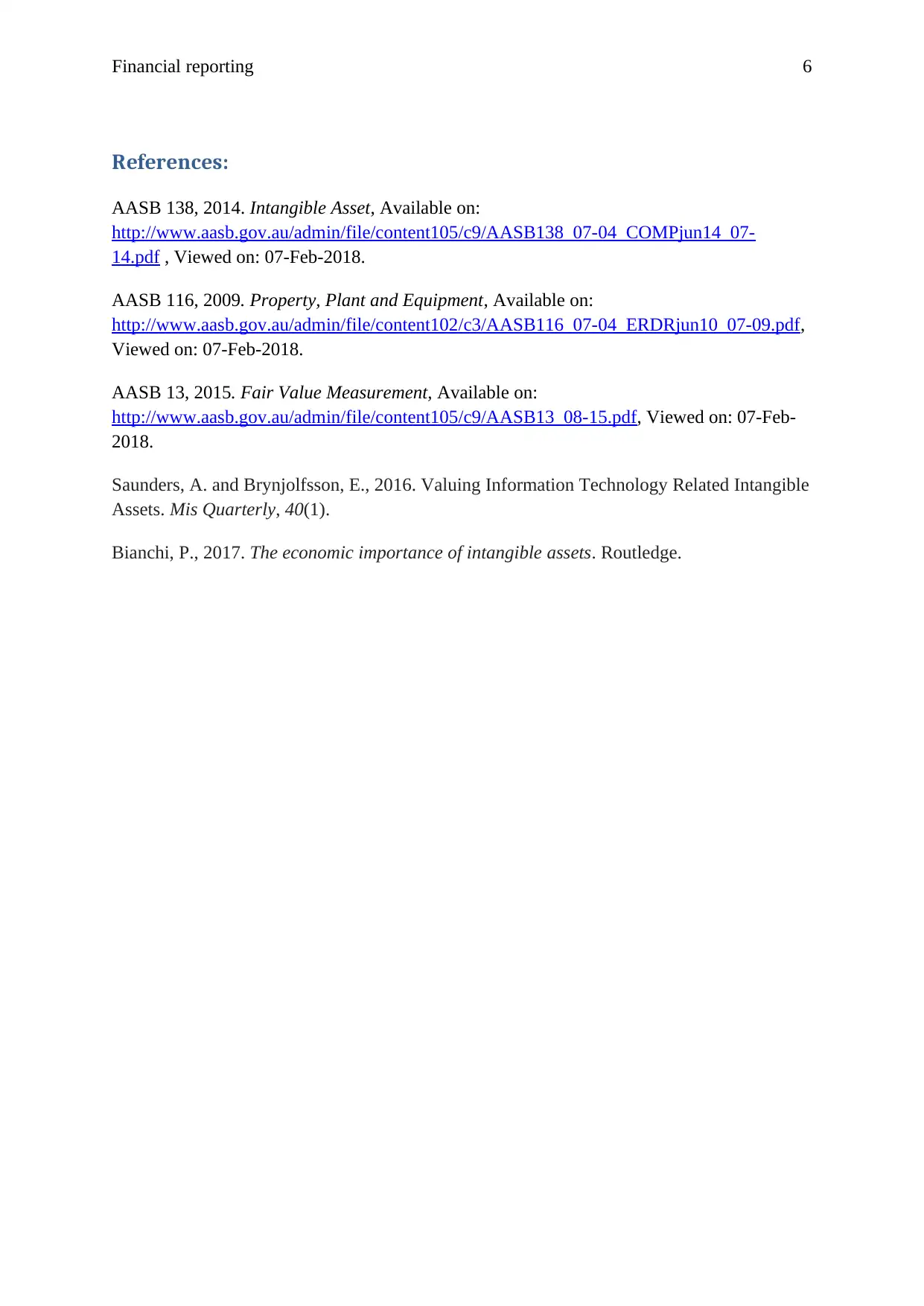ACC510 Financial Reporting Assignment: Fair Value and Research - ATMC
VerifiedAdded on 2023/06/15
|6
|1104
|262
Homework Assignment
AI Summary
This ACC510 Financial Reporting assignment solution addresses questions related to fair value as defined by AASB 13, its application in different contexts (accounting standards, ATO's definition, and court interpretations), and its practical implications for valuing shares. It also discusses the accounting treatment of research and development costs under AASB 138, differentiating between research and development activities and outlining the criteria for capitalizing development expenditures. The document references relevant accounting standards and academic literature to support its analysis. Desklib provides various study tools and resources, including similar assignments and past papers, to aid students in their academic endeavors.

Financial Reporting
Financial Reporting
Financial Reporting
Paraphrase This Document
Need a fresh take? Get an instant paraphrase of this document with our AI Paraphraser

Financial reporting 2
Table of Contents
Question 1.............................................................................................................................................3
Question 3.............................................................................................................................................5
References:............................................................................................................................................6
Table of Contents
Question 1.............................................................................................................................................3
Question 3.............................................................................................................................................5
References:............................................................................................................................................6

Financial reporting 3
Question 1
Part (i)
Fair value can be used in three different contexts they are:
1. Fair value to be used for the purpose of accounting standards
2. Fair market value as commonly used in the ATO’s definition of market value and
3. Fair market value as used by courts.
Fair market value is defined under AASB 13 as the predictable price at which an arranged
transaction to transfer the asset or to sell the asset takes place amongst the market participants
under current market conditions. The market participants are comprised of willing buyers and
willing sellers. This definition of fair value emphases on the assets and liabilities and also
applies on the entity’s own equity instrument (AASB 13, 2015).
The AASB 116 (property, plant and equipment) says that fair value is applied to both the
assets and liabilities which are marketable and to those which are not marketable. The
measurement will be same for both the cases. Fair value is also termed as the exit price this is
identified at the measurement date. In the case where market for the asset is not available
then the fair value of that asset or liability can be identified using the price of the identical
asset or liability. Ideally fair value measurement is particularly for an asset or liability but that
can be violated for the assets which have no market available as their value will be taken
using the value of the identical assets or liabilities (AASB 116, 2009).
The tax laws do not define fair value in a general context it is defined in the definition part of
the Income Tax Assessment Act 1997. The fair value is defined in the tax laws as the
estimated amount for which an asset can be traded between the willing seller and willing
buyer on the reporting date. The price fixed need to be determined with the help of arm’s
length transaction, and where the parties have acted prudently, knowledgeably and the fair
dealing is there between parties.
The fair value which is considered by courts is an estimated price which a willing,
knowledgeable and unpressurised buyer is owing to pay to the knowledgeable, unpressurised
and willing seller. Fair market value also differs from intrinsic value. This is actually an
Question 1
Part (i)
Fair value can be used in three different contexts they are:
1. Fair value to be used for the purpose of accounting standards
2. Fair market value as commonly used in the ATO’s definition of market value and
3. Fair market value as used by courts.
Fair market value is defined under AASB 13 as the predictable price at which an arranged
transaction to transfer the asset or to sell the asset takes place amongst the market participants
under current market conditions. The market participants are comprised of willing buyers and
willing sellers. This definition of fair value emphases on the assets and liabilities and also
applies on the entity’s own equity instrument (AASB 13, 2015).
The AASB 116 (property, plant and equipment) says that fair value is applied to both the
assets and liabilities which are marketable and to those which are not marketable. The
measurement will be same for both the cases. Fair value is also termed as the exit price this is
identified at the measurement date. In the case where market for the asset is not available
then the fair value of that asset or liability can be identified using the price of the identical
asset or liability. Ideally fair value measurement is particularly for an asset or liability but that
can be violated for the assets which have no market available as their value will be taken
using the value of the identical assets or liabilities (AASB 116, 2009).
The tax laws do not define fair value in a general context it is defined in the definition part of
the Income Tax Assessment Act 1997. The fair value is defined in the tax laws as the
estimated amount for which an asset can be traded between the willing seller and willing
buyer on the reporting date. The price fixed need to be determined with the help of arm’s
length transaction, and where the parties have acted prudently, knowledgeably and the fair
dealing is there between parties.
The fair value which is considered by courts is an estimated price which a willing,
knowledgeable and unpressurised buyer is owing to pay to the knowledgeable, unpressurised
and willing seller. Fair market value also differs from intrinsic value. This is actually an
⊘ This is a preview!⊘
Do you want full access?
Subscribe today to unlock all pages.

Trusted by 1+ million students worldwide

Financial reporting 4
enforced value which a legal authority say courts, law or tax regulation sets. This is an
absolute value for any defined product or service.
Part (ii)
As per AASB 13 the shares are valued at the closing price at the end of the reporting period
or we can say the exit price at the reporting dat. As per AASB 13 the fair value of the shares
is to be taken in for the valuation of the shares. In the present case the shares are valued at the
estimated price of the preceding and subsequent day. The company’s valuation is wrong as
the shares need to be valued at the fair value that is the exit price at the reporting date of the
shares needs to be taken for the valuation purpose. The above mentioned shares need to be
valued at $0.70 cents.
Part (iii)
The companies can choose the results that produce the lowest negative information and
greatest profit but that too need to be followed by the company consistently and if company
wants to change the method then there need to be a proper disclosure in the company’s notes
to accounts. The disclosure in company’s notes to account will help the investors to assess the
change to make the decisions accordingly.
enforced value which a legal authority say courts, law or tax regulation sets. This is an
absolute value for any defined product or service.
Part (ii)
As per AASB 13 the shares are valued at the closing price at the end of the reporting period
or we can say the exit price at the reporting dat. As per AASB 13 the fair value of the shares
is to be taken in for the valuation of the shares. In the present case the shares are valued at the
estimated price of the preceding and subsequent day. The company’s valuation is wrong as
the shares need to be valued at the fair value that is the exit price at the reporting date of the
shares needs to be taken for the valuation purpose. The above mentioned shares need to be
valued at $0.70 cents.
Part (iii)
The companies can choose the results that produce the lowest negative information and
greatest profit but that too need to be followed by the company consistently and if company
wants to change the method then there need to be a proper disclosure in the company’s notes
to accounts. The disclosure in company’s notes to account will help the investors to assess the
change to make the decisions accordingly.
Paraphrase This Document
Need a fresh take? Get an instant paraphrase of this document with our AI Paraphraser

Financial reporting 5
Question 3
Para 54 of AASB 138 defines the research is termed as planned and original investigation,
which is commenced with the objective of attaining new technical or scientific understanding
and knowledge. The tangible asset arising from research cannot be recognised. Example of
research is a company in the construction line undertaking tests or activities aimed at
obtaining knowledge about the new areas to be developed. The company is searching for
some new thing and the benefits of this will be available in future, at this point no future
economic benefit can be expected for the entity (AASB 138, 2014).
Para 58 of AASB 138 defined that development is next to research as development is the
application of the research findings on the intangible asset and other knowledge to the new or
substantially improved processes, services and systems of generating intangible asset. This is
done before start of the new project or any commercial production. Example of development
is as the car manufacturer undertaking the construction of car, design finalisation and testing
process on the pre-production model before launching the car (Saunders and Brynjolfsson,
2016).
Para 57 of AASB 138 states that when all the criteria are met and development outlays are
capitalised:
1. The possibility of completing the intangible asset in technical terms, so that it will be
open for use or sale
2. Its purpose to use or sell it and complete the asset
3. The future economic benefits that the intangible asset will generate in future are
assessable.
4. Financial, technical and other resources are available to complete the development
stage.
5. The expenditures that are attributable to the assets during the stage of development
are measured reliably (Bianchi, 2017).
Question 3
Para 54 of AASB 138 defines the research is termed as planned and original investigation,
which is commenced with the objective of attaining new technical or scientific understanding
and knowledge. The tangible asset arising from research cannot be recognised. Example of
research is a company in the construction line undertaking tests or activities aimed at
obtaining knowledge about the new areas to be developed. The company is searching for
some new thing and the benefits of this will be available in future, at this point no future
economic benefit can be expected for the entity (AASB 138, 2014).
Para 58 of AASB 138 defined that development is next to research as development is the
application of the research findings on the intangible asset and other knowledge to the new or
substantially improved processes, services and systems of generating intangible asset. This is
done before start of the new project or any commercial production. Example of development
is as the car manufacturer undertaking the construction of car, design finalisation and testing
process on the pre-production model before launching the car (Saunders and Brynjolfsson,
2016).
Para 57 of AASB 138 states that when all the criteria are met and development outlays are
capitalised:
1. The possibility of completing the intangible asset in technical terms, so that it will be
open for use or sale
2. Its purpose to use or sell it and complete the asset
3. The future economic benefits that the intangible asset will generate in future are
assessable.
4. Financial, technical and other resources are available to complete the development
stage.
5. The expenditures that are attributable to the assets during the stage of development
are measured reliably (Bianchi, 2017).

Financial reporting 6
References:
AASB 138, 2014. Intangible Asset, Available on:
http://www.aasb.gov.au/admin/file/content105/c9/AASB138_07-04_COMPjun14_07-
14.pdf , Viewed on: 07-Feb-2018.
AASB 116, 2009. Property, Plant and Equipment, Available on:
http://www.aasb.gov.au/admin/file/content102/c3/AASB116_07-04_ERDRjun10_07-09.pdf,
Viewed on: 07-Feb-2018.
AASB 13, 2015. Fair Value Measurement, Available on:
http://www.aasb.gov.au/admin/file/content105/c9/AASB13_08-15.pdf, Viewed on: 07-Feb-
2018.
Saunders, A. and Brynjolfsson, E., 2016. Valuing Information Technology Related Intangible
Assets. Mis Quarterly, 40(1).
Bianchi, P., 2017. The economic importance of intangible assets. Routledge.
References:
AASB 138, 2014. Intangible Asset, Available on:
http://www.aasb.gov.au/admin/file/content105/c9/AASB138_07-04_COMPjun14_07-
14.pdf , Viewed on: 07-Feb-2018.
AASB 116, 2009. Property, Plant and Equipment, Available on:
http://www.aasb.gov.au/admin/file/content102/c3/AASB116_07-04_ERDRjun10_07-09.pdf,
Viewed on: 07-Feb-2018.
AASB 13, 2015. Fair Value Measurement, Available on:
http://www.aasb.gov.au/admin/file/content105/c9/AASB13_08-15.pdf, Viewed on: 07-Feb-
2018.
Saunders, A. and Brynjolfsson, E., 2016. Valuing Information Technology Related Intangible
Assets. Mis Quarterly, 40(1).
Bianchi, P., 2017. The economic importance of intangible assets. Routledge.
⊘ This is a preview!⊘
Do you want full access?
Subscribe today to unlock all pages.

Trusted by 1+ million students worldwide
1 out of 6
Related Documents
Your All-in-One AI-Powered Toolkit for Academic Success.
+13062052269
info@desklib.com
Available 24*7 on WhatsApp / Email
![[object Object]](/_next/static/media/star-bottom.7253800d.svg)
Unlock your academic potential
Copyright © 2020–2025 A2Z Services. All Rights Reserved. Developed and managed by ZUCOL.





